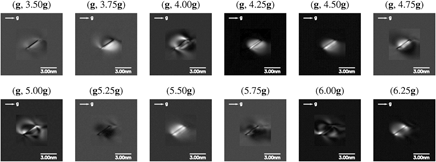Crossref Citations
This article has been cited by the following publications. This list is generated based on data provided by
Crossref.
Chen, Y.
Li, N.
Bufford, D.C.
Li, J.
Hattar, K.
Wang, H.
and
Zhang, X.
2016.
In situ study of heavy ion irradiation response of immiscible Cu/Fe multilayers.
Journal of Nuclear Materials,
Vol. 475,
Issue. ,
p.
274.
Lu, Qiaofeng
Su, Qing
Wang, Fei
Zhang, Chenfei
Lu, Yongfeng
Nastasi, Michael
and
Cui, Bai
2017.
Influence of laser shock peening on irradiation defects in austenitic stainless steels.
Journal of Nuclear Materials,
Vol. 489,
Issue. ,
p.
203.
Cui, Bai
Wang, Fei
Yan, Xueliang
Zhang, Chenfei
Deng, Leimin
Lu, Yongfeng
Nastasi, Michael
Liu, Jian
Hong, Minghui
and
Xiao, Rongshi
2018.
Fundamental mechanisms of laser shock processing of metals and ceramics.
p.
27.
Yi, Xiaoou
Arakawa, Kazuto
Ferroni, Francesco
Jenkins, Michael L.
Han, Wentuo
Liu, Pingping
and
Wan, Farong
2018.
High-temperature damage evolution in 10 keV He+ irradiated W and W-5Re.
Materials Characterization,
Vol. 145,
Issue. ,
p.
77.
Yu, Hongbing
Yi, Xiaoou
and
Hofmann, Felix
2018.
3D reconstruction of the spatial distribution of dislocation loops using an automated stereo-imaging approach.
Ultramicroscopy,
Vol. 195,
Issue. ,
p.
58.
Zhang, Xinghang
Hattar, Khalid
Chen, Youxing
Shao, Lin
Li, Jin
Sun, Cheng
Yu, Kaiyuan
Li, Nan
Taheri, Mitra L.
Wang, Haiyan
Wang, Jian
and
Nastasi, Michael
2018.
Radiation damage in nanostructured materials.
Progress in Materials Science,
Vol. 96,
Issue. ,
p.
217.
Kirk, Marquis A.
Li, Meimei
Xu, Donghua
and
Wirth, Brian D.
2018.
Predicting neutron damage using TEM with in situ ion irradiation and computer modeling.
Journal of Nuclear Materials,
Vol. 498,
Issue. ,
p.
199.
Roldán, Marcelo
Fernández, Pilar
Rams, Joaquín
Sánchez, Fernando José
and
Gómez-Herrero, Adrián
2018.
Nanoindentation and TEM to Study the Cavity Fate after Post-Irradiation Annealing of He Implanted EUROFER97 and EU-ODS EUROFER.
Micromachines,
Vol. 9,
Issue. 12,
p.
633.
Mason, D.R.
Sand, A.E.
Yi, X.
and
Dudarev, S.L.
2018.
Direct observation of the spatial distribution of primary cascade damage in tungsten.
Acta Materialia,
Vol. 144,
Issue. ,
p.
905.
Mason, D. R.
Yi, X.
Sand, A. E.
and
Dudarev, S. L.
2018.
Experimental observation of the number of visible defects produced in individual primary damage cascades in irradiated tungsten.
EPL (Europhysics Letters),
Vol. 122,
Issue. 6,
p.
66001.
Li, Wei
Field, Kevin G.
and
Morgan, Dane
2018.
Automated defect analysis in electron microscopic images.
npj Computational Materials,
Vol. 4,
Issue. 1,
Nathaniel, James E.
Lang, Andrew C.
El-Atwani, Osman
Suri, Pranav K.
Baldwin, Jon K.
Kirk, Marquis A.
Wang, Yongqiang
and
Taheri, Mitra L.
2019.
Toward high-throughput defect density quantification: A comparison of techniques for irradiated samples.
Ultramicroscopy,
Vol. 206,
Issue. ,
p.
112820.
Hu, Jing
Garner, Alistair
Frankel, Philipp
Li, Meimei
Kirk, Marquis A.
Lozano-Perez, Sergio
Preuss, Michael
and
Grovenor, Chris
2019.
Effect of neutron and ion irradiation on the metal matrix and oxide corrosion layer on Zr-1.0Nb cladding alloys.
Acta Materialia,
Vol. 173,
Issue. ,
p.
313.
Mason, D R
Sand, A E
and
Dudarev, S L
2019.
Atomistic-object kinetic Monte Carlo simulations of irradiation damage in tungsten.
Modelling and Simulation in Materials Science and Engineering,
Vol. 27,
Issue. 5,
p.
055003.
Yi, Xiaoou
Arakawa, Kazuto
Du, Yufeng
Ferroni, Francesco
Han, Wentuo
Liu, Pingping
and
Wan, Farong
2019.
High-temperature defect recovery in self-ion irradiated W-5 wt% Ta.
Nuclear Materials and Energy,
Vol. 18,
Issue. ,
p.
93.
Haley, J.C.
Liu, F.
Tarleton, E.
Cocks, A.C.F.
Odette, G.R.
Lozano-Perez, S.
and
Roberts, S.G.
2019.
Helical dislocations: Observation of vacancy defect bias of screw dislocations in neutron irradiated Fe–9Cr.
Acta Materialia,
Vol. 181,
Issue. ,
p.
173.
Mason, Daniel R.
and
London, Andrew J.
2020.
Morphological analysis of 3d atom probe data using Minkowski functionals.
Ultramicroscopy,
Vol. 211,
Issue. ,
p.
112940.
Yu, Hongbing
Karamched, Phani
Das, Suchandrima
Liu, Junliang
Mizohata, Kenichiro
and
Hofmann, Felix
2021.
New perspectives on collision cascade damage in self-ion irradiated tungsten from HR-EBSD and ECCI.
Journal of Nuclear Materials,
Vol. 554,
Issue. ,
p.
153074.
Alat, Ece
Hu, Jing
Wolfe, Douglas E.
and
Motta, Arthur T.
2021.
Zirconium in the Nuclear Industry: 19th International Symposium.
p.
149.
Emelyanova, O.
Gentils, A.
Borodin, V.A.
Ganchenkova, M.G.
Vladimirov, P.V.
Dzhumaev, P.S.
Golovchanskiy, I.A.
Lindau, R.
and
Möslang, A.
2021.
Bubble-to-void transition promoted by oxide nanoparticles in ODS-EUROFER steel ion implanted to high He content.
Journal of Nuclear Materials,
Vol. 545,
Issue. ,
p.
152724.



